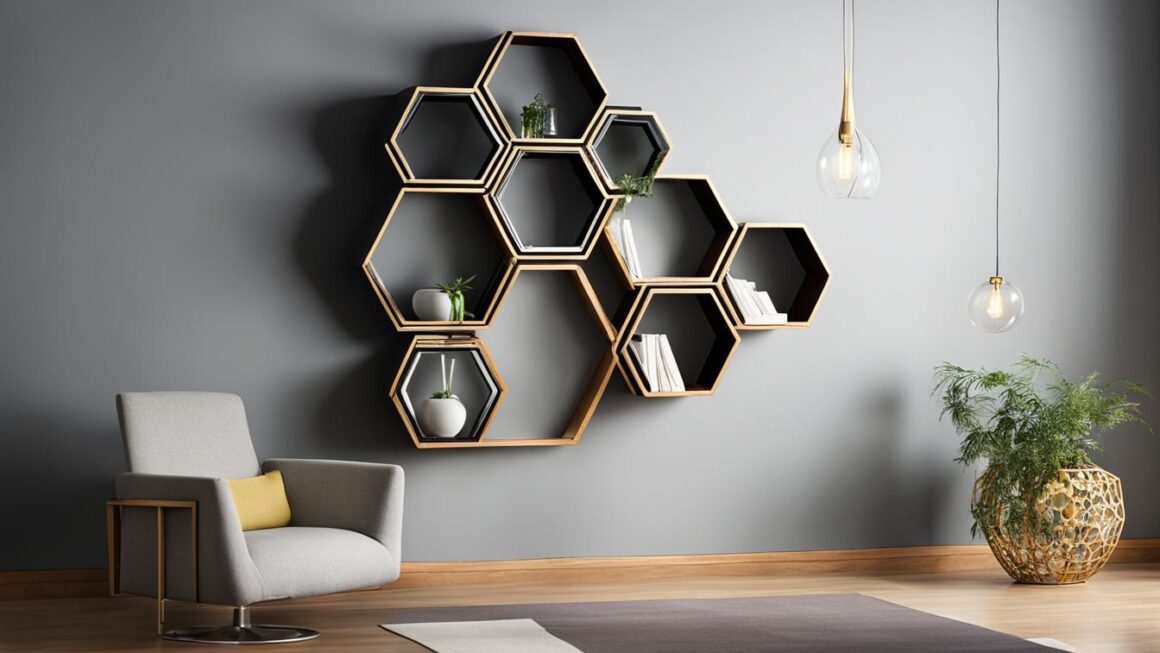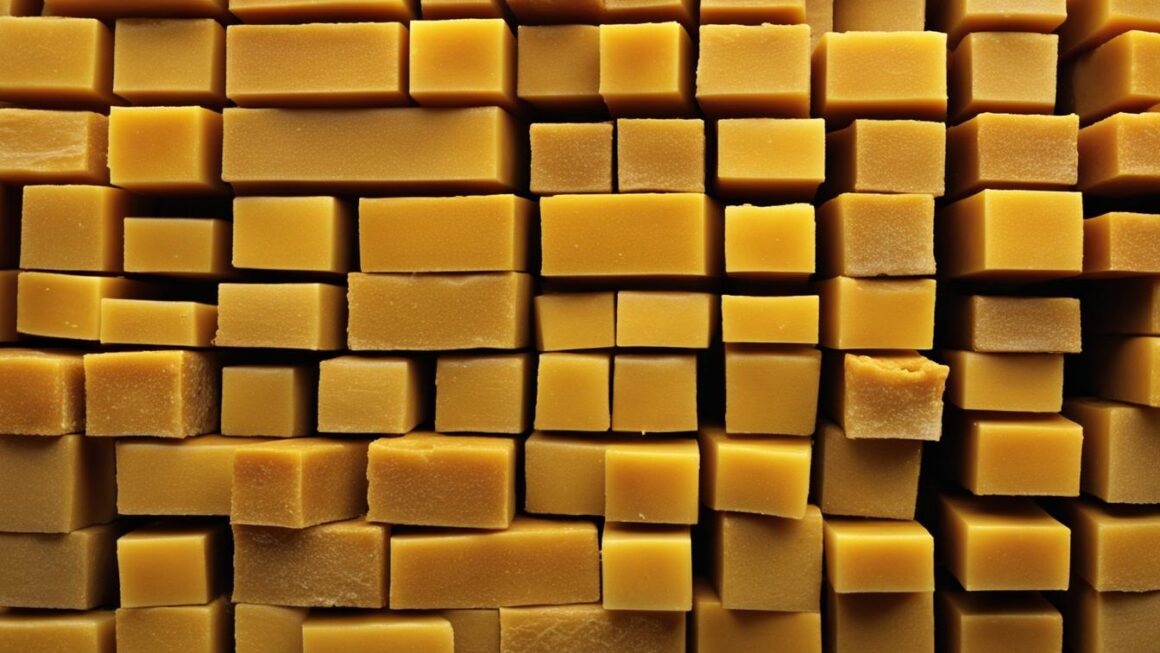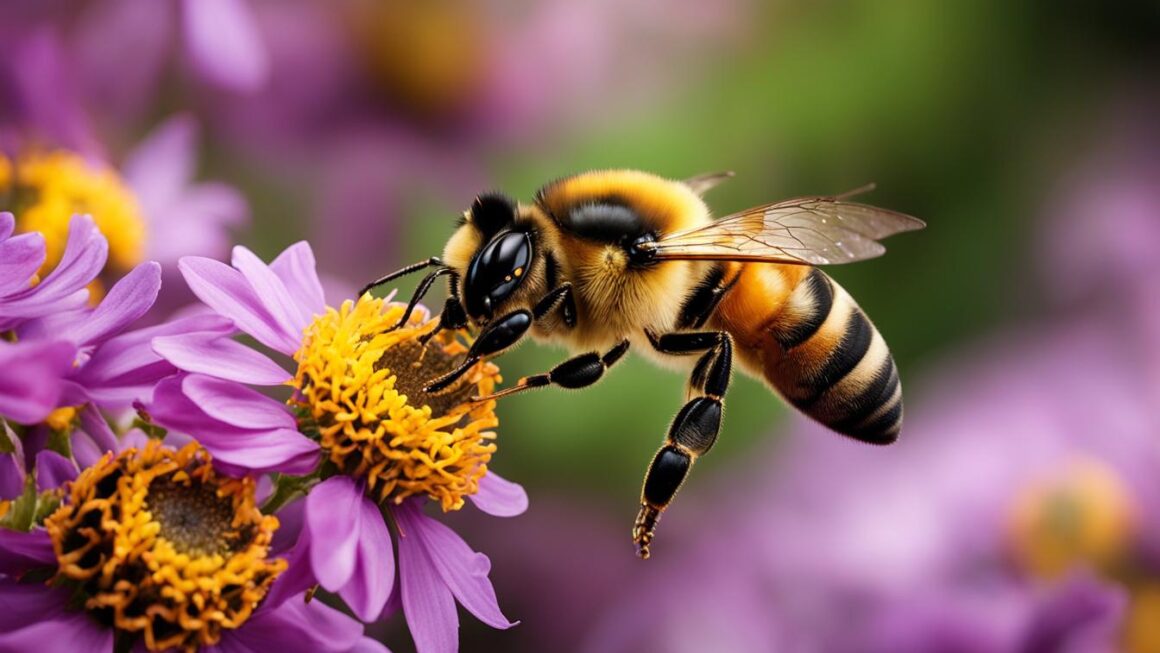Beeswax is a popular choice for protecting and enhancing wooden surfaces. It cleans, nourishes, and protects wood from fading, dust, and water damage. Beeswax provides a beautiful, natural shine without altering the appearance of the wood. It is easy to apply and suitable for all types of wooden surfaces, including furniture and hardwood floors. Additionally, beeswax can be used in conjunction with other wood finishes such as stain, oil, and varnish. Its traditional formula has been trusted by professionals and is a safe and effective way to bring new life to wood furniture.
Key Takeaways
- Beeswax is a versatile option for protecting and enhancing wooden surfaces.
- It provides a natural shine without altering the appearance of the wood.
- Beeswax can be used on all types of wooden surfaces, including furniture and hardwood floors.
- It can be used in conjunction with other wood finishes for added protection and beauty.
- Beeswax is a safe and effective way to revive and maintain the beauty of wood furniture.
Benefits of Using Beeswax on Wood
Using beeswax on wood offers numerous benefits, making it a popular choice for wood treatment and protection. It not only cleans and nourishes the wood but also provides a protective barrier against sun damage, dust, and water. The natural beeswax formula helps maintain the color, condition, and value of wooden furniture, making it a worthwhile investment.
One of the advantages of beeswax is its versatility. It is suitable for all types of wooden surfaces, whether it’s modern furniture or antique pieces. Beeswax can be applied to various wood types such as beech, mahogany, oak, pine, teak, walnut, and yew. So, regardless of the wood type or style of furniture, beeswax can enhance its natural beauty.
In addition to its protective properties, beeswax is also cost-effective. It is easy to apply and reapply, making it a long-lasting solution for maintaining wood furniture. Compared to other alternatives, beeswax offers a more affordable option without compromising on quality.
| Benefits of Using Beeswax on Wood |
|---|
| Protects against sun damage, dust, and water |
| Preserves the color, condition, and value of wooden furniture |
| Suitable for all types of wooden surfaces and wood types |
| Cost-effective solution for long-lasting wood maintenance |
Overall, using beeswax on wood provides a range of benefits. It not only protects and enhances the appearance of wooden furniture but also offers a cost-effective and versatile solution for wood treatment. By incorporating beeswax into your wood care routine, you can enjoy the timeless beauty of wood furniture for years to come.
How to Apply Beeswax on Wood
When it comes to applying beeswax on wood, there are a few simple steps to follow to ensure the best results. First, it’s important to start with a clean surface. Use a specialist wood cleaner to remove any dirt or grime, ensuring that the wood is free from dust and debris. This will allow the beeswax to penetrate and protect the wood effectively.
Once the surface is clean, take a lint-free cloth and apply the beeswax furniture polish onto it. Rub the polish into the wooden surface, following the direction of the grain. This will ensure an even application and help the wax to penetrate the wood fibers. Allow the beeswax to sit on the wood for a few minutes, giving it time to nourish and protect the surface.
After a few minutes, take a clean cloth and buff the waxed surface. This will remove any excess wax and restore the natural shine of the wood. For added protection, additional coats of beeswax can be applied, especially on bare wood. The process of applying beeswax to wood is suitable for various wooden surfaces, including furniture, hardwood floors, and even wooden veneers, helping to preserve their beauty and durability.
Benefits of Using Beeswax on Wood:
- Provides protection against sun damage, dust, and water
- Maintains the color, condition, and value of wooden furniture
- Enhances the natural beauty of the wood
- Cost-effective compared to other alternatives
- Suitable for all types of wooden surfaces and wood types
Making Beeswax Furniture Polish at Home
Beeswax furniture polish is a popular choice for wood enthusiasts who prefer a natural and cost-effective solution. Making your own beeswax furniture polish at home is simple and allows you to customize the formula to suit your preferences. By following these easy steps, you can create a high-quality polish that will rejuvenate and protect your wood furniture.
Ingredients:
- Beeswax pellets or blocks
- Conditioning oil (such as mineral oil or fractionated coconut oil)
- Essential oils (optional for adding fragrance)
To make the beeswax furniture polish, start by melting the beeswax in a double boiler or slow cooker. Once melted, add the conditioning oil in a 1:3 ratio of wax to oil. Stir the mixture well to ensure the ingredients are thoroughly combined. If desired, you can add a few drops of your favorite essential oil for a pleasant scent.
Pour the mixture into a container for storage, such as a glass jar or tin. Allow it to cool and solidify before use. The homemade beeswax furniture polish is now ready to be applied to your wood furniture.
How to Apply:
Before applying the beeswax polish, make sure the wood surface is clean and dry. Use a lint-free cloth to gently apply the polish in a circular motion, following the grain of the wood. Allow the polish to sit for a few minutes to penetrate the wood. Then, using a clean cloth, buff the surface to a shine.
For additional protection or on bare wood, you can apply multiple coats of the beeswax furniture polish. Simply repeat the application process, allowing each coat to dry completely before applying the next one.
Making your own beeswax furniture polish gives you complete control over the ingredients and allows you to create a product that is safe and effective for your wood furniture. With regular application, the beeswax polish will nourish and protect the wood, enhancing its natural beauty and longevity.
Using Beeswax Furniture Polish on Damaged Pieces
Beeswax furniture polish can be a game-changer when it comes to reviving damaged wood furniture. Whether you have a beloved antique piece or a modern item that has seen better days, beeswax polish can help bring it back to life. The natural properties of beeswax provide nourishment, protection, and a beautiful finish for damaged wood surfaces.
To begin the restoration process, it’s crucial to ensure that the wood is thoroughly cleaned and free of any paint or buildup. An all-natural paint remover or paint thinner can be used to remove any existing coatings. Once the wood is clean and dry, it’s time to apply the beeswax polish.
Take a clean, dry cloth and apply the beeswax polish in circular motions, ensuring that the entire damaged area is coated. Allow the polish to sit on the wood for approximately 15 minutes, allowing it to penetrate and work its magic. After the waiting period, use a fresh, clean cloth to buff away any excess polish and reveal the revived wood surface. The beeswax polish will not only revive the appearance of the wood but also provide a protective layer against future damage.
Remember, when using beeswax furniture polish on damaged pieces, it’s essential to be patient and thorough. Take the time to properly clean the wood and apply the polish evenly. By following these steps, you can restore the beauty of your damaged wood furniture and enjoy its timeless appeal for years to come.
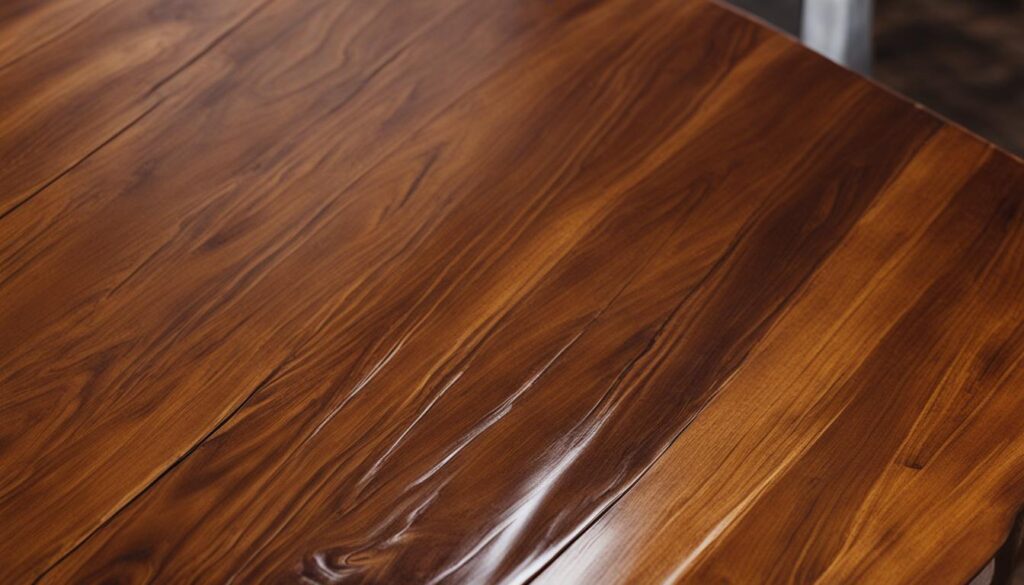
Example Table: Comparison of Beeswax and Other Wood Finishes
| Finish | Pros | Cons |
|---|---|---|
| Beeswax | Natural, nourishing, protective, enhances wood’s appearance | May require frequent reapplication |
| Oil-based Finish | Enhances wood’s natural color, provides protection | May darken wood, requires regular maintenance |
| Varnish | Durable, long-lasting protection | Can alter wood’s appearance, requires careful application |
In comparison to other wood finishes, beeswax offers a natural and nourishing option for damaged wood furniture. While it may require more frequent reapplication, the results are well worth the effort. Experiment with different finishes to find the perfect solution for your specific wood furniture restoration needs.
Tips for Using Beeswax on Wood
When it comes to using beeswax on wood, there are a few tips and tricks that can help you achieve the best results. Whether you’re applying it to wooden furniture or hardwood floors, following these guidelines will ensure a successful application and long-lasting protection for your wood surfaces.
Choose a Clean and Dry Surface
Before applying beeswax polish, make sure the wood surface is clean and dry. Remove any dust, dirt, or grime using a gentle wood cleaner or a damp cloth. This will ensure that the beeswax adheres properly and provides maximum protection.
Use Lint-Free Cloths
When applying and buffing the beeswax polish, it’s important to use lint-free cloths. This will prevent any fibers from getting caught on the wood surface, resulting in a smooth and even application. Microfiber cloths or old cotton t-shirts work well for this purpose.
Follow the Wood Grain
Always apply and buff the beeswax polish following the direction of the wood grain. This will help to evenly distribute the polish and enhance the natural beauty of the wood. Working against the grain may result in an uneven finish and can potentially damage the wood surface.
By following these tips, you can effectively use beeswax on wooden furniture and hardwood floors, preserving their beauty and extending their lifespan. Regular maintenance and reapplication of the beeswax polish will keep your wood surfaces looking their best for years to come.
| Benefits | Considerations |
|---|---|
| Enhances the natural beauty of wood | May require regular reapplication |
| Provides protection against sun damage, dust, and water | Can be slippery when used on hardwood floors |
| Cleans and nourishes wood | Not suitable for wood with a glossy finish |
| Easy to apply and reapply | May darken lighter wood types |
Using beeswax on wood offers a natural and effective way to protect and enhance wooden surfaces. Its versatility and ease of use make it a popular choice for furniture and flooring. By following the proper application techniques and maintenance tips, you can enjoy the long-lasting benefits of beeswax on your wood.
The Versatility of Beeswax for Wood
Beeswax is a highly versatile product when it comes to treating and protecting wood. It can be used on a wide range of wooden surfaces, making it a valuable tool for both modern and antique furniture. From beech to mahogany, oak to teak, beeswax is suitable for various wood types, providing nourishment and enhancing their natural beauty.
Not only does beeswax offer protection and rejuvenation for wooden furniture, but it can also be used in conjunction with other wood finishes. Whether you’ve stained or oiled your furniture, applying beeswax afterwards can enhance the color and provide an additional layer of protection. This versatility makes beeswax a popular choice among professionals and DIY enthusiasts alike.
Furthermore, beeswax is not limited to furniture. It can be used on hardwood floors and even wooden veneers, ensuring that all wooden surfaces in your home receive the same level of care and protection. Its natural properties and ability to nourish and restore wood make it a preferred choice for those looking to maintain the longevity and beauty of their wooden pieces.
| Wood Types | Applications |
|---|---|
| Beech | Furniture, floors, veneers |
| Mahogany | Furniture, floors, veneers |
| Oak | Furniture, floors, veneers |
| Pine | Furniture, floors, veneers |
| Teak | Furniture, floors, veneers |
| Walnut | Furniture, floors, veneers |
| Yew | Furniture, floors, veneers |
Whether you’re looking to protect your wooden furniture, revitalize worn-out floors, or simply enhance the natural beauty of wood, beeswax provides a versatile and effective solution. Its ability to nourish, protect, and bring out the best in wood makes it a must-have for any wood care arsenal.
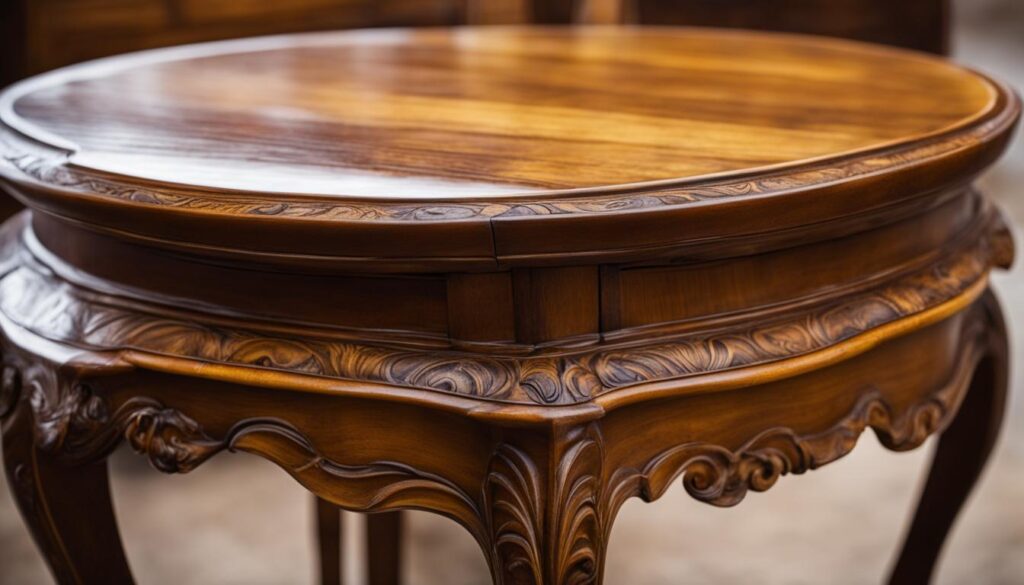
Beeswax Furniture Polish as a Natural Alternative
Beeswax furniture polish offers a natural alternative to commercial polishes that often contain synthetic components and harsh chemicals. The natural beeswax formula cleans, nourishes, and protects wood without altering its color or appearance. It provides a beautiful, rich finish and enhances the value of wood furniture. By using beeswax polish, you can avoid exposure to potentially harmful ingredients found in other products. It is a safe and effective way to preserve and enhance the natural beauty of wooden pieces.
Using beeswax furniture polish has numerous benefits for maintaining and protecting wood. The gentle cleaning properties of beeswax remove dust and dirt from the surface of the wood, revealing its natural beauty. The nourishing properties of beeswax penetrate the wood, preventing it from drying out and cracking. It also forms a protective barrier against moisture, preventing water damage and warping. Unlike some commercial polishes that can leave a sticky residue or alter the color of the wood, beeswax polish provides a natural shine while preserving the original appearance of the wood.
“Beeswax furniture polish is a great eco-friendly alternative to conventional polishes. It not only enhances the beauty of wood but also protects it from environmental damage. Its natural composition makes it safe to use and its pleasant scent adds a touch of luxury to any room.” – Woodworking Expert
Furthermore, beeswax furniture polish is easy to apply and reapply as needed. It can be rubbed onto the wood surface using a clean, lint-free cloth, and buffed to a shine. Regular application of beeswax polish can help maintain the protective layer on the wood, ensuring its longevity and durability. In addition, beeswax can be used on various wooden surfaces, including furniture, wooden floors, and even wooden veneers, making it a versatile product for all your wood care needs.
Summary:
- Beeswax furniture polish offers a natural alternative to commercial polishes, avoiding exposure to synthetic components and harsh chemicals.
- It cleans, nourishes, and protects wood without altering its color or appearance, providing a beautiful, rich finish.
- Beeswax forms a protective barrier against moisture, preventing water damage and warping.
- Regular application of beeswax polish helps maintain the protective layer on wood, ensuring its longevity and durability.
- It is easy to apply and suitable for various wooden surfaces, including furniture, wooden floors, and wooden veneers.
| Benefits of Beeswax Furniture Polish | Commercial Polishes |
|---|---|
| ✓ Natural and eco-friendly | ✘ May contain synthetic components |
| ✓ Preserves original wood color and appearance | ✘ May alter the color of the wood |
| ✓ Nourishes and prevents wood from drying out | ✘ May leave a sticky residue |
| ✓ Forms a protective barrier against moisture | ✘ May not provide adequate moisture protection |
| ✓ Easy to apply and reapply | ✘ May require frequent application |
Beeswax Furniture Polish Recipe
Creating your own beeswax furniture polish is a simple and cost-effective way to protect and revive your wooden furniture. With just a few ingredients, you can make a natural polish that will enhance the beauty and longevity of your wood surfaces.
To make the beeswax furniture polish, you will need beeswax and a conditioning oil, such as mineral oil or fractionated coconut oil. Start by melting the beeswax in a double boiler or slow cooker. Once melted, add the oil in a 1:3 ratio of wax to oil. Stir well until the mixture is fully combined.
Next, pour the mixture into a container for storage and let it cool and solidify. Once the polish has hardened, it is ready to use. Simply apply a small amount of the beeswax polish to a clean cloth and rub it onto the wood surface in a circular motion. Follow the direction of the grain to ensure even coverage.
Let the polish sit on the wood for a few minutes, allowing it to penetrate and nourish the surface. Then, use a clean cloth to buff away any excess polish, revealing a beautiful, natural shine. Regularly applying the beeswax polish will help protect your wood furniture from drying out, fading, and other forms of damage.
Benefits of Making Your Own Beeswax Furniture Polish:
- Cost-effective: Making your own beeswax polish is more economical compared to purchasing commercial alternatives.
- Natural Ingredients: By using beeswax and conditioning oil, you can ensure that your furniture polish contains only natural ingredients.
- Customizable Scents: Adding essential oils to your homemade polish allows you to tailor the scent to your preference.
“Creating your own beeswax furniture polish is a simple and cost-effective way to protect and revive your wooden furniture.”
Conclusion
Beeswax is a versatile and effective solution for maintaining and enhancing the beauty of wood furniture. Its natural properties make it an ideal choice for cleaning, nourishing, and protecting wooden surfaces. Whether you prefer to purchase commercially available beeswax furniture polish or make your own at home, the benefits are undeniable.
By applying beeswax on wood furniture, you can enjoy a range of advantages such as sun protection, dust resistance, and water repellency. The traditional formula of beeswax has long been trusted by professionals and homeowners alike for its ability to bring new life to wooden surfaces without altering their appearance.
Whether you have modern or antique furniture made of beech, mahogany, oak, pine, teak, walnut, or yew, beeswax is suitable for all types of wood. It can be used on various wooden surfaces, including furniture, hardwood floors, and even wooden veneers. By properly applying and maintaining beeswax, you can preserve the timeless appeal and durability of your wooden furniture for years to come.
FAQ
How do I use beeswax on wood?
Beeswax can be applied to wooden surfaces by first ensuring the surface is clean and dust-free. Use a lint-free cloth to apply the beeswax furniture polish in the direction of the wood grain. Let it sit for a few minutes, then buff it with a clean cloth to restore the shine.
What are the benefits of using beeswax on wood?
Beeswax cleans, nourishes, and protects wood from sun damage, dust, and water. It helps to maintain the color, condition, and value of wooden furniture. Beeswax is easy to apply, suitable for all types of wood, and provides a natural shine without altering the appearance of the wood.
How do I apply beeswax to wood?
Before applying beeswax, ensure the wood is clean and dry. Use a lint-free cloth to rub the beeswax furniture polish onto the wooden surface, following the direction of the grain. Let it sit for a few minutes, then buff it with a clean cloth for a polished finish.
Can I make my own beeswax furniture polish?
Yes, you can make your own beeswax furniture polish by melting beeswax in a double boiler or slow cooker, then adding a conditioning oil such as mineral oil or fractionated coconut oil. Stir well and pour the mixture into a container for storage. Once cooled and solidified, the homemade polish can be used to treat and protect wood.
Can beeswax be used on damaged wood furniture?
Yes, beeswax can be used to refinish damaged wood furniture. Before applying the polish, thoroughly clean the wood and remove any paint or buildup. Once the wood is dry, apply the beeswax polish using a clean cloth, following the instructions provided. The beeswax polish will help revive the wood and provide a protective finish.
What are some tips for using beeswax on wood?
It’s important to ensure the wood is clean and dry before applying beeswax polish. Use lint-free cloths to avoid leaving behind fibers on the surface. Always follow the direction of the wood grain when applying and buffing the polish. For hardwood floors, apply beeswax thinly and evenly, avoiding excessive buildup. Regularly maintain the wood by cleaning it with a wood cleaner and reapplying the beeswax polish as needed.
Can beeswax be used on different types of wood?
Yes, beeswax is suitable for all types of wood, including modern and antique furniture, as well as various wood types like beech, mahogany, oak, pine, teak, walnut, and yew. Beeswax can also be applied after staining or oiling wood furniture, enhancing the color and providing additional protection.
How does beeswax furniture polish compare to commercial polishes?
Beeswax furniture polish offers a natural alternative to commercial polishes that often contain synthetic components and harsh chemicals. The natural formula of beeswax cleans, nourishes, and protects wood without altering its color or appearance. It provides a beautiful, rich finish and enhances the value of wood furniture.
How can I make beeswax furniture polish at home?
To make your own beeswax furniture polish, melt beeswax in a double boiler or slow cooker, then add a conditioning oil like mineral oil or fractionated coconut oil in a 1:3 ratio of wax to oil. Stir well and pour the mixture into a container for storage. Once cooled and solidified, the homemade polish can be used to treat and protect wood furniture.
What are the benefits of using beeswax on wood furniture?
Beeswax cleans and nourishes wood, provides protection against sun damage, dust, and water, and enhances the natural beauty of the wood. It is a cost-effective and natural solution for preserving and revitalizing wood furniture.


